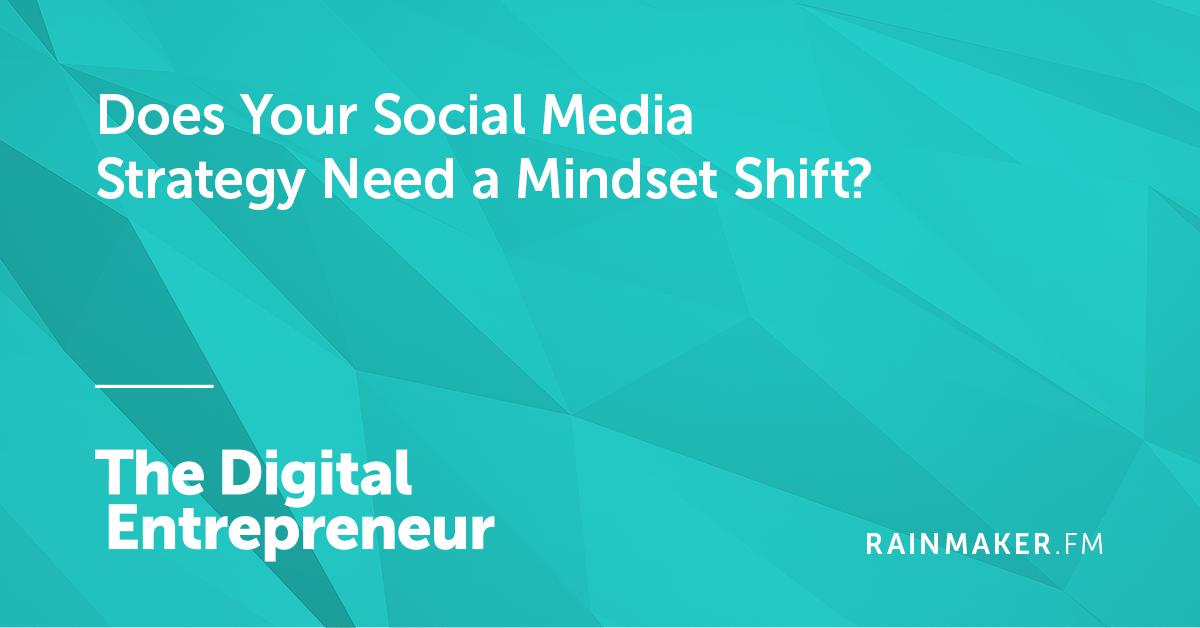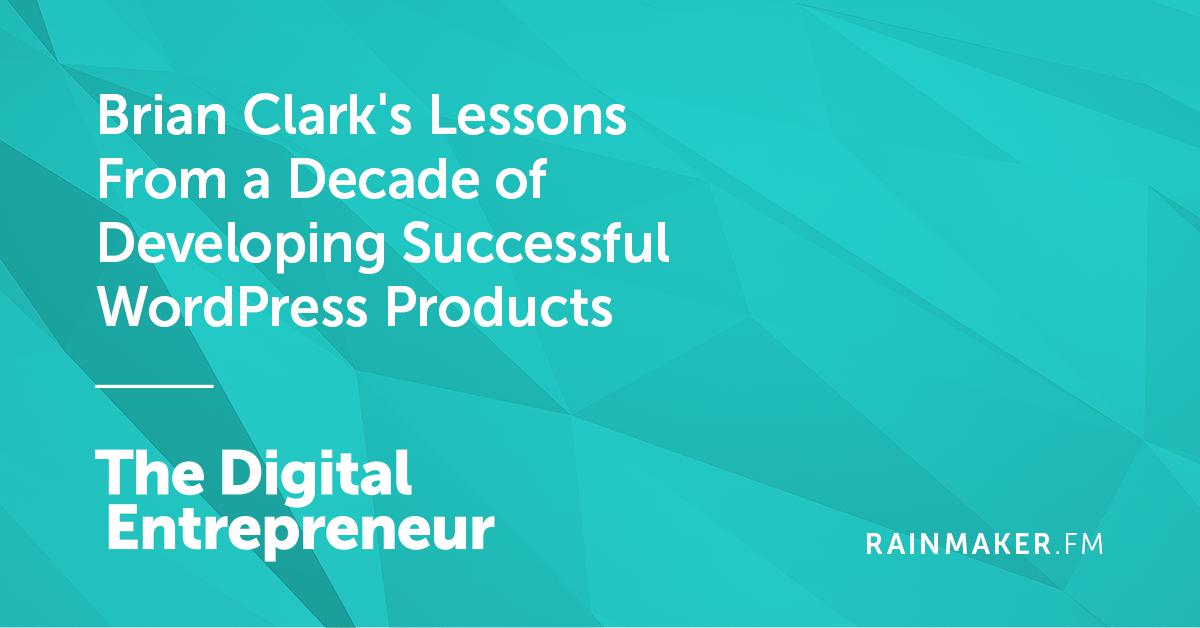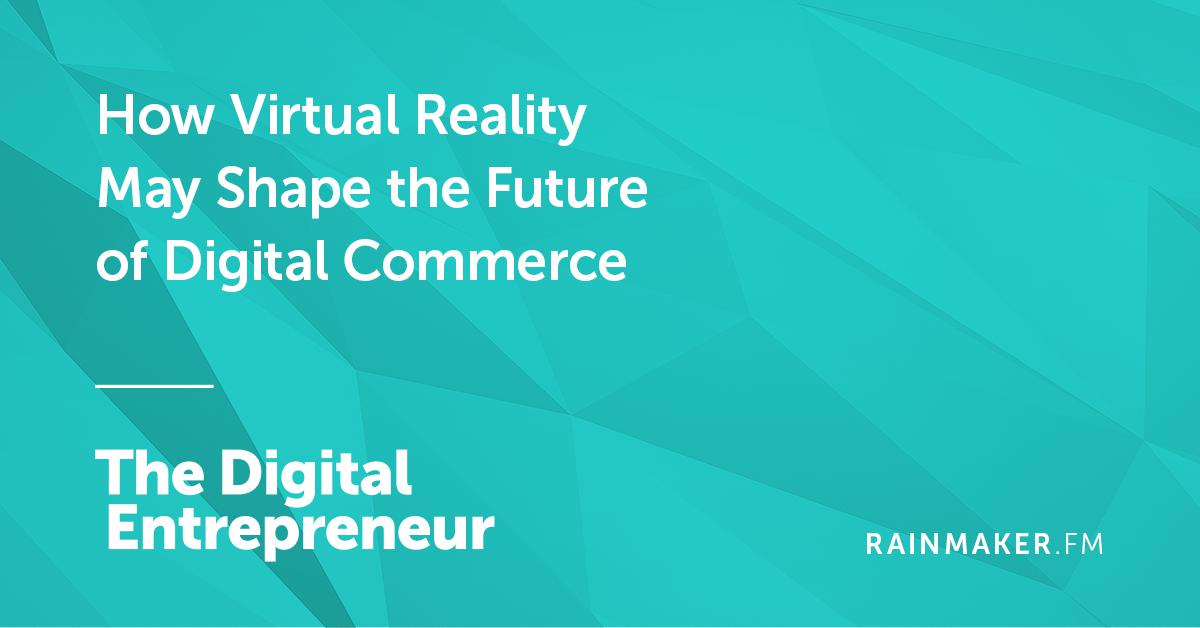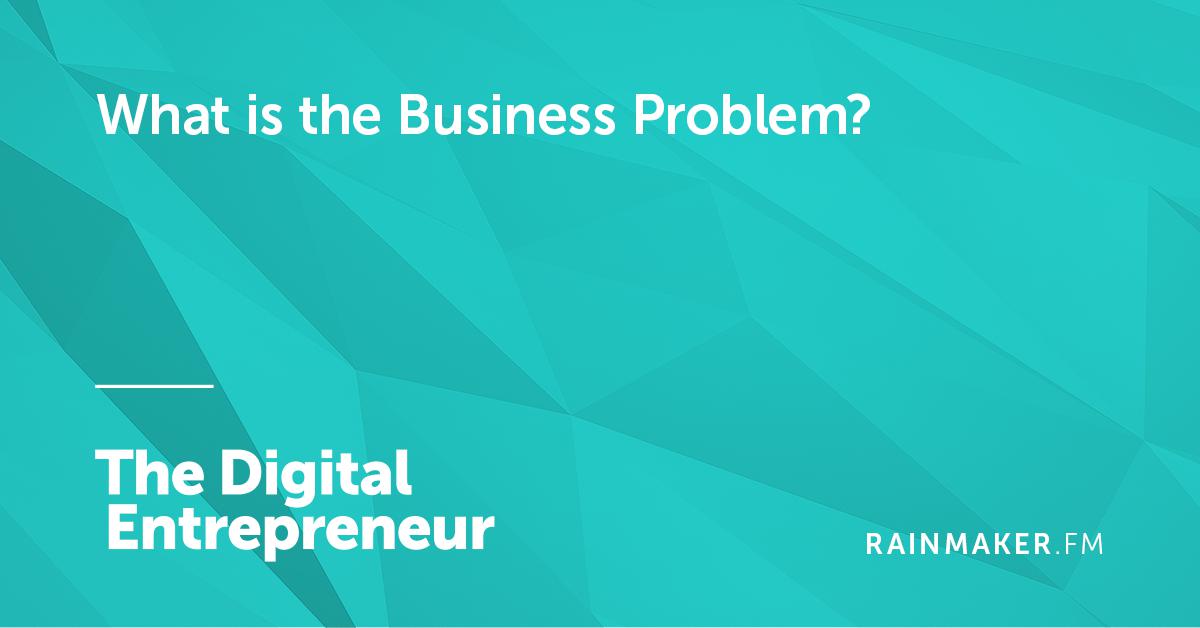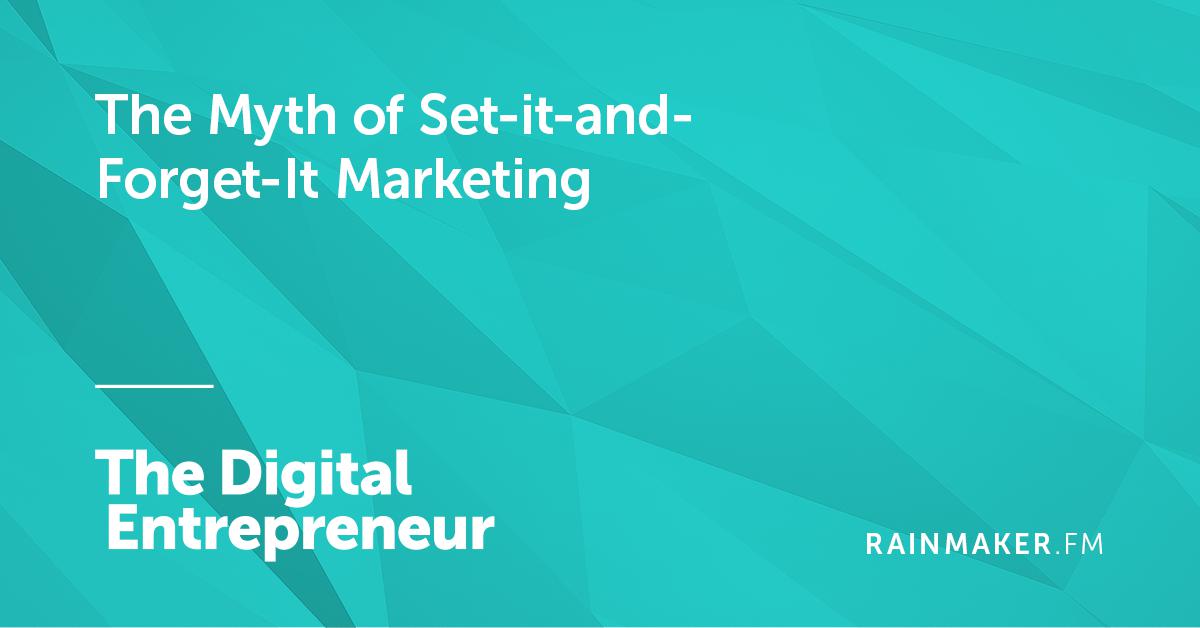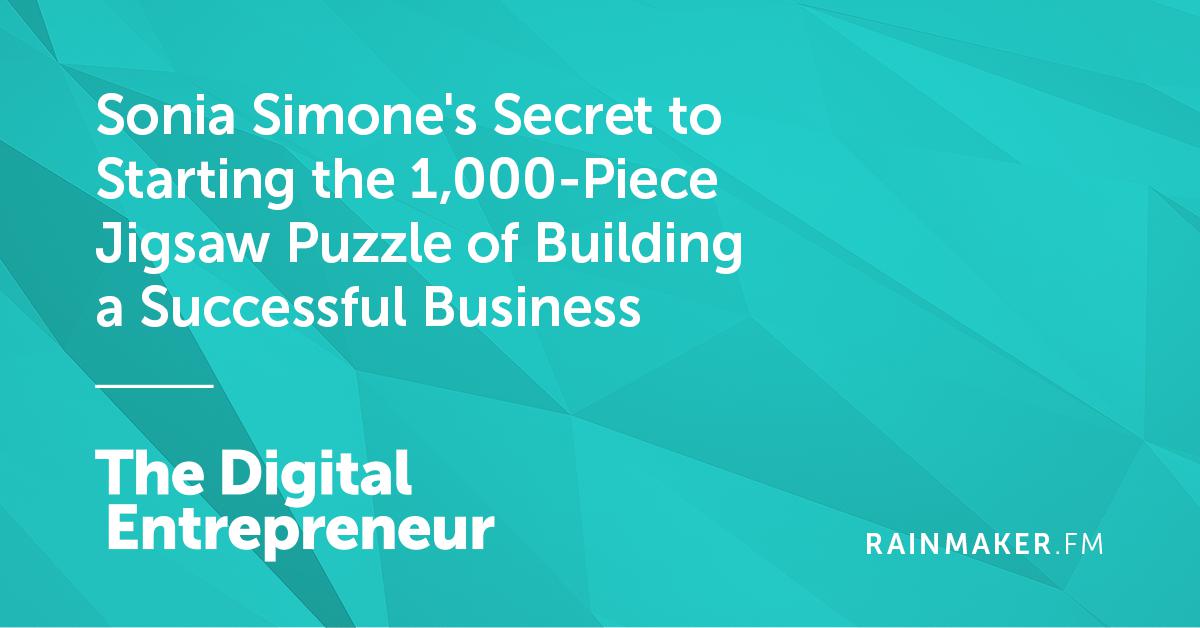
What is the biggest difference between a perpetually aspiring digital entrepreneur, who has all the ideas in the world … and a successful digital entrepreneur, who actually goes out and gets things done?
Sonia Simone, Chief Content Officer and Founding Partner of Rainmaker Digital, says there are two factors; and the first one is the key to getting started with what she refers to as the “1,000-piece jigsaw puzzle” of building a successful business.
In this 25-minute episode, Sonia shares a number of enlightening and empowering thoughts with us, all inspired by the closing keynote she will giving at Digital Commerce Summit this October (Early bird tickets are still available) …
- Why is focusing on mindset a worthwhile investment of our time and energy?
- How the mindset of an entrepreneur is more of a skill to be developed than simply an innate talent
- The biggest difference between wantrepreneurs and successful entrepreneurs
- How to take the first steps in any daunting project, including launching a business
- Why successful digital entrepreneurs are those who know how to “venture outside of the shallow end of the pool”
- ONE essential habit that you can develop right now that will move you forward and get positive momentum building
Listen to The Digital Entrepreneur below …
The Show Notes
- Digital Commerce Summit — get Early Bird tickets before the price goes up!
- @SoniaSimone
- Confessions of a Pink-Haired Marketer — Sonia’s podcast
- Digital Commerce Institute
- Jerod Morris
The Transcript
Sonia Simone’s Secret to Starting the 1,000-Piece Jigsaw Puzzle of Building a Successful Business
Voiceover: You’re listening to the Digital Entrepreneur, the show for folks who want to discover smarter ways to create and sell profitable digital goods and services. This podcast is a production of Digital Commerce Institute, the place to be for digital entrepreneurs. DCI features an in-depth, ongoing instructional academy, plus a live education and networking summit where entrepreneurs from across the globe meet in person. For more information, go to Rainmaker.FM/digitalcommerce. That’s Rainmaker.FM/digitalcommerce.
Jerod Morris: Welcome back to another brand new episode of the Digital Entrepreneur. This is episode number 17 of the Digital Entrepreneur. I am your host, Jerod Morris, the VP of Marketing for Rainmaker Digital. I am joined by one of my great work colleagues, one of my good friends, and one of the co-founders of Rainmaker Digital. She is also the chief content officer. A person, a voice, a personality that you know well, Ms. Sonia Simone. Who is also a keynote speaker at the upcoming Digital Commerce Summit. Sonia, how are you doing?
Sonia Simone: I’m good. I’m having a good day, doing my thing.
Jerod Morris: Very good. I definitely appreciate you taking the time to talk with us today. We have a really important topic to talk about which I feel like sometimes we kind of shy away from and feel like we’re wasting time almost if we talk about it, but it really is important. We’re going to get to that in just a second. The reason why you’re going to be talking about that with us is because it’s going to be what your closing keynote is about at Digital Commerce Summit.
Most of you listening have probably heard us talk about Digital Commerce Summit before, but if you haven’t, Digital Commerce Summit is the premier live educational and networking event for people who create and sell digital products and services. That’s the big tag line. More casually, it is our annual event. We’ve put on an annual event now for a couple of years. This is now the new annual event that we are doing in conjunction with Digital Commerce Academy, which we launched toward the end of last year.
So Digital Commerce Summit will really focus on the underlying process behind creating and selling digital goods and services. It’s going to be a great event for networking and also a great event for learning from people like Sonia. People like Brian Clark, Rand Fishkin, Chris Ducker, Chris Lema, and Jeff Walker. A lot of really great people are going to be there sharing their expertise and sharing their insight, and we want to tell you about it because currently the early bird pricing is still available — it’s $795 for a ticket. It will eventually go up to $995, so I wanted to make sure that you had another opportunity to hear about it, another reason to go. Go check out the URL Rainmaker.FM/summit and that will give you more details about it.
Don’t do it quite yet. Listen in, because the best way to get details about this is to actually hear from one of the speakers and hear her talk about one of the things that she’s going to be talking about. That’s what we’re going to talk about with Sonia today. Sonia, your closing keynote — which is going to be on the first day of Digital Commerce Summit — the title of it is “It’s All In Your Head: Developing the Digital Entrepreneur Mindset.”
Why is Focusing on Mindset a Worthwhile Investment of Our Time and Energy?
Jerod Morris: I want to start out by playing devil’s advocate for a minute to kick things off. Isn’t mindset talk just a bunch of frou-frou nonsense? Wouldn’t we be better served by just delving into tried-and-true tactics and rolling up our sleeves and getting to work? Why do we need to worry about mindset?
Sonia Simone: Jerod, I’m shocked and offended you would ask that question. I’m not really shocked and offended. It’s interesting, because in our company that’s actually the real question. Brian Clark will ask me, “Why are we doing this?” The answer really comes out of my experience — particularly at conferences. I think that anybody who’s ever been to a good conference where you get a lot of information, a lot of good things that you can use, you think, “Oh, yeah. I can totally try that. That would work. I’m sure that would work. I’m going to try that out.”
You get so many things that you’re going to implement, and you get home and if you do one thing it’s a miracle. Knowing what to do matters. It is important. You want to be working on things that have the best chance of succeeding for your individual unique combination of topic and skills and strengths and weaknesses. You want tactics. Tactics are very important. But if you do not implement then you don’t get results, there’s no way around it. It’s so easy for us to say, “Yeah, I’m totally going to implement. This time I’m going to implement. It’s not going to be like all those other times when I didn’t implement. This time I’m going to implement.”
Really the point of the talk … First of all, where it’s positioned is at the end of day one. You’ve got a head full of juicy ideas. You’re fired up. You know that some of these things are going to make a material difference. The timing of this is so that you get up and you go back to your room for a half hour before you go out to the party and you do something. You actually implement something. And you really can. In a half hour it’s amazing how much you can get done. It’s about getting the spark while the fire is still burning and using it.
Also learning what’s going to keep you implementing, what’s going to keep that momentum rolling as you move forward. Because we don’t want you to get fired up at the conference, have a wonderful time, go home, and have the same exact thing that you had before the conference. The whole point of the conference is transformation and action. That’s why we’re talking mindset. It’s really about getting yourself to do the things that you know will be beneficial.
Jerod Morris: Yeah, You know what’s so interesting about that? You’ll appreciate this. About 15 minutes ago while I was preparing for our conversation I had this spark of inspiration. I was scrolling through Digital Commerce Summit and I saw the description for my own presentation — which I’m giving on the first day — and it led me to this idea for what my first slide can be and the opening statement that I can make. It just hit me, and I was like, “Oh crap, what should I do with this real quick? Should I open up a Google doc?” I was like, “Let me just pull out a notecard. I already know what I’m going to do with it.”
That’s something that you and I — we went to a conference together back in February, a really transformative conference. One of the things that we learned is this whole notecard idea and this way to capture ideas and organize presentations. It’s great. It’s amazing that that still — it doesn’t just linger on, it literally drives.
I know you do this. I do this. And that has been so much of our inspiration — different tweaks that we want to make to our conference to add to it, to make it better. That’s what a great conference should do, really spit you out — yes, with the tactics and with new strategies. But, like you said, they are pointless if when you fly back home, by the time you land you’ve forgotten about them or if you don’t have the motivation or whatever it takes to actually implement them.
Here we are months later and we’re still doing all this stuff from the conference that we went to. That’s our goal with Digital Commerce Summit, for people to be feeling the same way months, even years after the conference because of what they’ve learned and what they’ve gained in this direction — if they’re really excited to go in it.
Sonia Simone: Yeah, Exactly.
Jerod Morris: You know what else is interesting too? In terms of the structure of the conference, your presentation coming at the end of the first day. It’ll be a really interesting bookend to Rand Fishkin’s opening keynote in which he’s going to share the story of Moz and the many highs and lows along the way, a lot of which were driven by his fluctuating mindset and how that all played into it. I think it will be a really interesting bookend to see one of those presentations at the beginning and then yours at the end. It will be a great way to kick off and end that first day.
Sonia Simone: I agree. It’s going to be interesting.
How the Mindset of an Entrepreneur Is More of a Skill to Be Developed than Simply an Innate Talent
Jerod Morris: Okay, let’s get back to talking about mindset here. How is the mindset of a digital business owner — a digital entrepreneur — a skill rather than an innate talent? And why is that distinction important?
Sonia Simone: I think this comes up a lot for people. There are some people — and typically it’s because there’s something in your background that opened this idea up to you — that will look at a tactic and they’ll say, “That’s a good idea.” And they just sit down and do it. The Gary Vaynerchuk type. That kind of high energy, hyped up, action-oriented, not necessarily … A lot of those people are not great planners and they’re not great long-term strategic people, but they get a lot of stuff done. They throw a lot of spaghetti against the wall and some of it sticks.
I think there’s a belief — and it’s very prevalent, especially in the United States — that that is the kind of person who can own a business. That that is the sort of temperament that business owners have. If you don’t have that temperament in your DNA, then you don’t get to own a business. That that’s the only kind of person who can be a successful business owner. But also that a certain amount of that habit of just sitting down and getting it done — just sit down and knock something out real quickly and see what happens — that that’s always an innate trait and that it’s not something that we can learn. We can learn so much more than we think we can. I love Carol Dweck’s work on fixed mindset versus growth mindset.
A fixed mindset is, “I have a certain set of talents. I have a certain intelligence. I have a certain level of energy and drive. That’s what I’ve got and the degree to which I succeed or fail is based on the cards that I was dealt and we’re done with the conversation.” The growth mindset is, “I can get better at things I’m not good at. I can find workarounds for things that are not strengths. Maybe I can either figure out a creative way to not do them, figure out a creative way to partner, or just get better.” A lot of times we can get better at a lot more things than we think we can.
That growth mindset is a question of realizing it. Maybe just noticing in yourself where you have this fixed mindset comes up — most of us have it about some things — and then reminding yourself that that’s not the only way to think about it. It’s not useful, it doesn’t serve you. It’s really much more a collection of habits than it is your DNA. Some people are by nature a little more optimistic, and some people are definitely by nature more introverted or extroverted. There are things that are innate. But you can work with almost any kind of personality type if you can just figure out a good habit set that suits you. That’s where we’re always talking about how unique every business is, because every business owner is so different.
Jerod Morris: Since I’ve known you I don’t think there’s any topic that I’ve seen you get as worked up about, and I mean that in a good way, passionate about outside of this idea that entrepreneurs are born rather than made. Is that something that you’ve seen over and over again? Where people that we might classify as, “they don’t have the traits to be an entrepreneur,” but they’ve gone on to be successful? Have you seen lots of examples of that happening because people have cultivated the skills and habits to make it happen?
Sonia Simone: I have. I think I get cranky about it because for so many years I totally bought into it. I was never much of a salesperson. I was never any good at it. It always made me feel weird, even when I was a kid selling raffle tickets. I like to joke that I couldn’t sell raffle tickets to my grandmother, mostly because I couldn’t make the call and then I couldn’t close the sale. It seemed kind of weird.
I was held back by it for a long time, and really only was able to resolve it from having my back against the wall because I was in a really difficult economy and jobs were not findable. Then, at the same time, I had been reading Copyblogger as a total fangirl and trying things, and they were working better than I thought they could. I started to see that that limitation maybe was being promulgated by people who didn’t know what they were talking about, so I started looking around.
For every trait that you hear passed around as gospel, “A true entrepreneur must have this trait” — one of them is you have to be able to sell. Well, you really don’t, especially now. You have to be able to persuade, but there’s so many ways to do that. It’s not just about cold calling somebody and talking them into something. There’s lots of ways to persuade. Also decisiveness — that comes right out of Harvard Business School, this notion that you have to be decisive as a business owner. Right or wrong, you just have to decide on something and do it. That’s one of the reasons for so many high-profile crashes and burns with CEOs, because they lead their company right off the cliff. “I made a decision and now we’re going to do it.” Well, your decision was terrible.
The business owner with the highest market cap that I know personally, is like a squirrel who can’t cross the street. This guy changes his mind 28 times a day. It makes his people nuts. It’s not necessarily a strength, but I will tell you that no movement happens in that company that hasn’t been well thought out. He also surrounds himself with people who counterbalance that and make sure that there’s movement and drive. I’ve seen people who are not that smart make great businesses. I’ve seen people who are very introverted and really have no interest in getting themselves to get out there and glad-hand. Glad-hand is a verb only introverts use, right?
I just can’t think of a trait that everybody says, “You can’t be a business owner if you have that trait.” In most cases, I could give you two, three, four, five examples of people I know personally. I’ve become very cranky about gurus who tell you that you can’t based on their experience and based on what they’ve seen. In my experience, most of the time, if you’re willing to be creative and you’re willing to look at it in a different way and you’re going to get your head on straight — you can make something work.
Jerod Morris: There are people listening to this show right now who maybe had more of a fixed mindset before, but they’ve started listening to the Digital Entrepreneur, they’ve read stuff on Copyblogger, they’ve listened to other podcasts, consumed other content, and they’ve started to get more of that growth mindset. They’ve started to say, “All these other people are out there creating these successful businesses online or off, so certainly there’s a huge opportunity digitally.” They’re starting to get more of this growth mindset and think, “Hey, maybe I could be an entrepreneur too.” But then there’s that next step between thinking about it and talking about it and getting courses and listening to podcasts and actually going out and doing it.
The Biggest Difference Between Wantrepreneurs and Successful Entrepreneurs
Jerod Morris: Even though we’re talking about the importance of mindset and how anyone can do it, that doesn’t mean that it’s an easy or even a simple transition to make. What do you think is the biggest difference between that perpetually aspiring digital entrepreneur who has all the ideas in the world and a successful digital entrepreneur who actually goes out and will get things done?
Sonia Simone: I think it’s probably two factors. Some people will fall into one and some people will fall into the other. The most common one in my experience is everyone, you, me, Brian Clark, everyone, starts a business or starts a project — it might not even be a business, it might be a project at first — and it’s overwhelming. I think of it as a thousand-piece jigsaw puzzle. You look at it and it’s a mess. You don’t know how anything goes together. It’s a little hard to figure out where to start. The successful people, just like the successful people who can solve a jigsaw puzzle, take the easiest thing — in a jigsaw puzzle it’s the corners and the sides, the edges — they take the easiest thing that they know how to do and then they start doing it.
It’s very much a question of … Maybe they have a small habit of doing it. If you’re an okay writer or a good writer, then your easy step is “I’m going to pay somebody like $100 to install WordPress for me because it’s overwhelming to even think about that. Then I’m going to start just writing some things down as a blog. I don’t know where it’s going to go, but I’m going to just do that.”
How to Take the First Steps in Any Daunting Project, Including Launching a Business
Sonia Simone: You start in your comfort zone and you start with what you know you can do every day, a little bit every day. You don’t start with, “I’m going to spend six hours a day on my digital business. Every day between 2:00 and 8:00 in the morning I’m going to work on my digital business and then I’m going to go out and do my job.” It’s not going to happen.
Start small, start in your comfort zone, and make it a habit. People who do that start to see momentum. Momentum, by its nature, breeds more momentum. People who don’t do that, they either think too big: “I’m going to do the whole thing now. I can’t do the whole thing now.” It’s depressing. It’s hard. It starts to kick up all kinds of mindset problems. “I can’t do this. I’m too stupid. I don’t have the drive.” And they fail. That’s the first thing.
The second thing is sometimes people will stay in that space for a very long time. They’ll stay in the comfort zone. They’ll stay in the modest habit that they know how to do and they never put their little toe in the water of the thing that’s not in their comfort zone, technology, persuasion in selling, a new format, or a bigger project that requires more steps. Sometimes people will have been blogging and have been doing all the comfortable things for 2 years, 5 years, 10 years, or more than that, and say, “I never got any traction.” It’s because you stayed in the baby part of the pool. The whole point of the baby part of the pool is to get you comfortable with the water so that you can venture into a little bit deeper water and get your skills in a little bit better shape.
Those are the two things I’ve seen, and both of those can be fixed today if you just decide to do something differently today. The easiest way to start in both cases is to have a little habit. If you’re going to do something that makes you nervous, like selling, then maybe you have, “Okay, I’m going to do 10 minutes of selling practice a day. On Monday I’m going to write headlines, on Tuesday I’m going to write calls to action, and on Wednesday I’m going to read my free My Copyblogger library and come up with a persuasion technique.” You get the idea. Every day you’re going to take a little practice time to do something that don’t feel too good and feels a little weird and a little uncomfortable. That’s how you get comfortable, is practice.
Jerod Morris: Yeah, I love that metaphor of the small end of the pool getting you used to the water so you can go into the deep end, but you have to make sure that you venture out there at some point. Otherwise, you’ll just stay in the shallow end forever.
Sonia Simone: Yeah.
One Essential Habit That You Can Develop Right Now That Will Move You Forward and Get Positive Momentum Building
Jerod Morris: You kind of answered this one, but I’m wondering if we can even go a little bit more specific with it. I want folks who are listening to this to really get something to take away from this episode, something they can do literally right now, once they get off of this, or tomorrow, or as soon as possible. If you could talk to everybody who’s going to listen to your keynote right now — several months before it’s actually going to happen — and if you could inspire them to foster one habit before the conference to be a step or two ahead of the game by October, what would that be?
I know you just went through a few of them in terms of stepping outside of people’s comfort zones. And some of those will be dependent, obviously, on what a person is aspiring to do, what their background is, all of that. But is there one thing that people could start doing that would be useful to everybody that would put people a few steps ahead before the conference?
Sonia Simone: Some of you already know what your thing is going to be. Some of you are listening to this and saying, “I should do that for writing blog posts. I should do that for writing a sales page.” If you’re listening to this and you’re like, “I know exactly what to do,” set yourself a daily habit. Put a timer on your phone. If you can do it every day, that really is great. But if it could only be five minutes a day, that would be okay. If you already know, “The next thing for me to get good at is getting better at writing, or doing more writing, or learning about podcasting.” If you already know it, then just set up your timer right now. Set it up now, even if you don’t know what you’re going to fill that time with. Set up 5 minutes a day, 10 minutes a day. If you could do 20 a day, that would be awesome.
It’s totally cool to work up to it. This week you’ll do five minutes, and then next week you’re going to reset your timer setting and you’re going to do it for six minutes every single day, then seven minutes every single day. If you don’t know yet what that might be, then take either your favorite Rainmaker FM podcast — maybe you’re a big Digital Entrepreneur listener, or a big Unemployable listener, or the Copyblogger blog would be another place — read it every day or listen to it. Maybe listen to a different Rainmaker FM episode a day. You’ll get a call to action on one of those. You’ll get a tactic to try, something you can practice.
Then just do that every day. This will probably air in June. It’s only June and the event is in October, so if you’re like a ninja in eight weeks — don’t stay in the baby end of the pool. Come up with another one. “What would be one little small step a little outside my comfort zone on that? What would be a little harder?” Really, if you only spend five minutes a day in the baby pool between now and October, you’ll be amazed at how much actually happens.
Jerod Morris: It’s so important to be better now, to go do this now. We have these moments of inspiration. Someone is listening to you talk right now, Sonia, and they’re like, “Yeah, I want to start doing that.” They don’t do anything with it and three or four days later they’ve forgotten about it. Their motivation has dissipated and it’s like they’re starting back at — not necessarily square one, because they’ve listened to this so they know it intellectually, but they haven’t necessarily matched that with the emotion and with the action that will create the momentum which you talked about earlier.
It’s so important. If you’re feeling that motivation right now from listening to Sonia talk, don’t put your headphones down and say, “I’m going to do it,” and not do it. Just do something quick and small right now — whether it’s putting a to-do in your to-do list, blocking off 10 minutes on your calendar, or actually sitting down and doing something, like going and listening to an episode of Confessions of a Pink Haired Marketer for example — taking that first step. It’s so important to take that first step. Don’t wait till later to be better. Be better right now.
Sonia Simone: Yeah.
Jerod Morris: Sonia, this is wonderful. I, for one, cannot wait to hear your presentation in October. It’s going to be wonderful, as all of the presentations will be. It’s going to be a really fun conference.
Sonia Simone: I’ll give all you guys a little secret, that Jerod and I are going to be watching each other’s presentations very closely because we did both go to this event where we learned to be stronger speakers and more dynamic and to broaden the range of what we bring to our talks. Jerod and I are both looking at each other like, “Okay, game on.” We’re going to try and see how much we can implement to make these really move you to action and really make a difference in your life.
That’s what makes what we do fun. When I have people come up to me and say, “You know what? That was the thing that made me understand how it worked and I’m doing something differently now,” there’s nothing like that. I want to thank all of you. I sure hope you come and see us live, but whether you do or whether you don’t, that’s really what I want for all of you guys. It’s really what makes it worth doing for me, and I know that that’s true with Jerod as well.
Jerod Morris: Yes. If either Sonia or I start impersonating air or wind or fire, you can send a tweet to Victoria Labalme and ask her, “Why in the world are they doing this?” All right, that URL one more time is rainmaker.fm/summit. Go there and you’ll get the full description. There’s a band that’s going to be playing. We’re having a party. So you can check that out, find out who the band is. It’s going to be fantastic. You can see all of the speakers, who they all are and what they will be talking about. Check out the dates, and of course, check out the price.
Again, it’s 795 right now. That price will be going up, so depending on when you listen to this the price might have gone up already. But certainly if you listen to this soon after it’s out you can still get that early bird price. Again, go to rainmaker.fm/summit and join us in Denver. We’d love to see you, and we hope that we will see as many of you there as possible. All right, everybody. Sonia, thank you so much for being here. For the wonderful episode. We really appreciate your insight.
Sonia Simone: Thank you. I had a great time. It’s always good talking with you.
Jerod Morris: It is. Thank you for listening. We will talk to you next week on another brand new episode of the Digital Entrepreneur.
